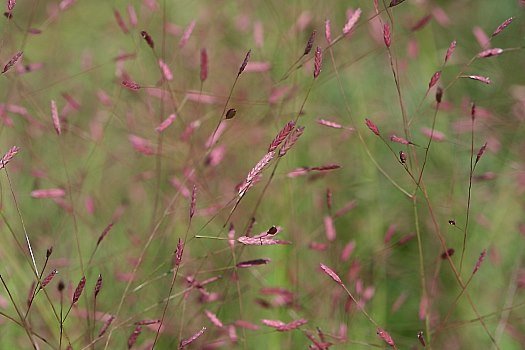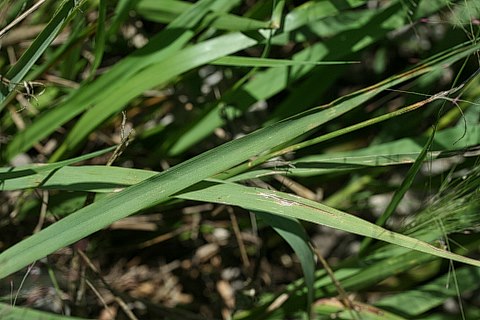Description: This perennial grass is 1-2' tall and tufted at the base with erect to widely spreading culms. Each culm has 3-4 alternate leaves; it is unbranched, light green to light tan, glabrous, and mostly hidden by the sheaths. The leaf blades are 3-8 mm. across and up to 10" long; they are medium green, ascending to widely spreading, and usually hairless (except near the base of the blade). The leaf sheaths are open, rather loose, and more or less hairy. However, sometimes the upper sheaths are hairless. Each ligule consists of a ring of long white hairs; these hairs are conspicuous at the junction of each blade and sheath.

The inflorescence
is up to 15" long and 12" across, globoid-ovoid in overall shape, and
larger than the rest of the plant; it consists of an airy panicle of
spikelets with widely spreading branches. Along the central axis
(rachis) of this panicle, there are whorls of 3 branches, which divide
into smaller branches. At each whorl along the central axis, there is a
small tuft of hair. Sometimes smaller tufts of hair can be found where
the branches divide into smaller branches. These branches are very
slender and somewhat stiff. Individual spikelets occur on slender
pedicels; these pedicels are usually longer than the spikelets. The
spikelets are about 4-7 mm. long, 1.5 mm. across, and flattened; they
are pale purple to bright purple when the florets bloom, but later
become light tan. Each spikelet consists of a pair of glumes and 5-15
lemmas in two columnar ranks. The lemmas are 1.5–2.0 mm. long, ovate,
folded along their keels, and 3-veined. The glumes are lanceolate,
folded along their keels, and a little shorter than the lemmas. The
blooming period occurs from late summer to early fall. At maturity, the
entire inflorescence can become detached and blow about in the wind,
thereby distributing the seeds. The root system is fibrous and
rhizomatous.
Cultivation:
Preferred growing conditions are full sun and dry barren soil
containing sand or gravel. Because of a C4 metabolism, most vegetative
growth occurs during the summer when the weather is warm. This
low-growing grass is resistant to drought.
Range & Habitat:
Purple Love Grass is occasional to locally common throughout Illinois;
this native grass has been found in every county (see Distribution
Map). Habitats include hill prairies, sand prairies, upland
savannas and sandy savannas, limestone glades, sandy or gravelly areas
along railroads, sandy or gravelly roadsides, sandy paths, and fields.
Disturbed sandy areas are preferred.

Faunal
Associations:
There is limited information about floral-faunal relationships for this
species. The leafhopper Flexamia areolata sucks
juices from the foliage of Purple Love Grass; the caterpillars of Poanes
zabulon (Zabulon Skipper) also feed on the foliage. The
foliage of young plants is palatable to cattle and other livestock.
Photographic Location:
Along a railroad in Champaign, Illinois.
Comments:
The large inflorescence is attractive, forming a purple haze in the
distance. Purple Love Grass has spread throughout the state along roads
and railways, but it is selective in the habitats that it invades. On
moist fertile ground, taller grasses and forbs will displace this
species. Compared to many other Eragrostis spp. (Love
Grasses), Purple Love Grass has wider leaf blades (3-8 mm. across), an
inflorescence that is longer than the rest of the plant, pedicels that
are longer than the spikelets, and more showy purple spikelets. There
is some variation in the size of the spikelets, lemmas and glumes;
also, the hairiness of the foliage can be variable across different
populations.